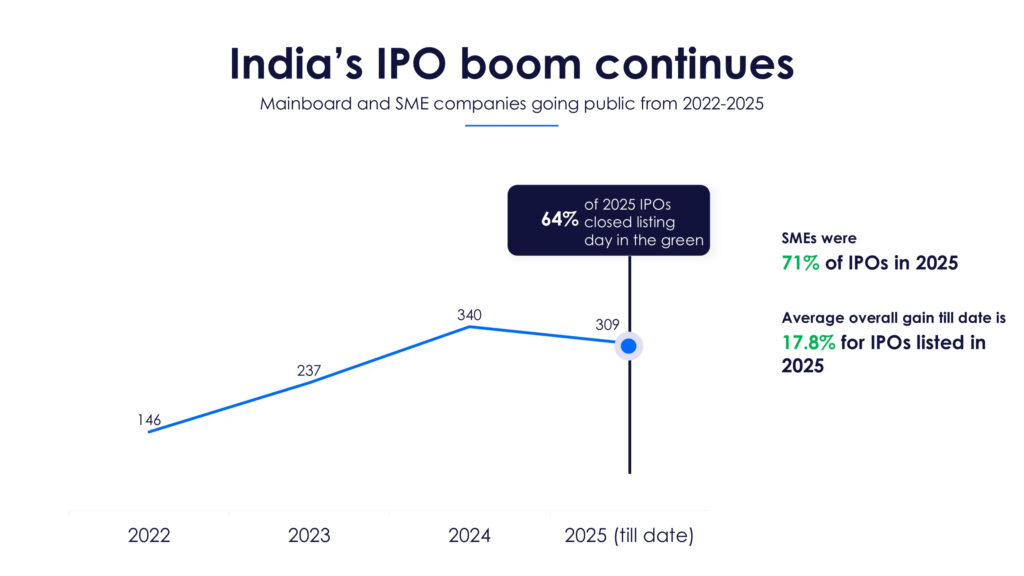Over 300 companies went public raising nearly $16 billion; smaller IPOs dominate as retail investors fuel the frenzy
NEW DELHI (India CSR): After a blockbuster year for initial public offerings (IPOs) in 2024, analysts expected 2025 to bring a slowdown amid rising market uncertainty. Instead, India’s IPO train has shown no signs of stopping. More than 300 companies have gone public so far this year, collectively raising close to $16 billion, making India the fourth most active IPO market in the world.
From financial giants like Tata Capital and LG Electronics to digital players like Groww, 2025 has been a year of high investor enthusiasm and record participation. The real story, however, is not just the number of listings—but who is driving them: India’s growing army of retail investors.
The Rise of the Retail Investor
In 2025, India’s retail investors have emerged as a formidable force in the capital markets. Families now channel nearly 5% of their savings into equities and mutual funds, up from 2.5% in 2020—a doubling in just five years.
Retail participation in IPOs has exploded. Of the 300-plus offerings this year, 93% received full retail subscription, and the median oversubscription stood at 7.7 times the available shares. This surge marks a powerful shift—one that is democratizing access to wealth creation opportunities once dominated by institutional investors.
In fact, nearly two-thirds of IPOs in 2025 delivered listing gains, meaning that even investors with basic participation strategies—“buying and holding on listing day”—had a good chance of earning profits.

Small is Big: SME IPOs Dominate 2025
While large names grabbed headlines, the real action has been in the small and medium enterprise (SME) segment. Over 70% of this year’s IPOs came from smaller companies, with an average market capitalization of just ₹249 crore.
Retail investors have rushed into these smaller issues, often pushing oversubscription levels into the hundreds. Austere Systems, for instance, saw a retail oversubscription of 1,400 times despite a market cap of only ₹15.7 crore and weak fundamentals. Other small-cap IPOs like Citichem India and Fabtech Cleanrooms drew oversubscriptions of 522x and 950x, respectively.
However, experts caution that these smaller issues come with high volatility and liquidity risk. Many SME stocks experience wide bid-ask spreads, low trading volumes, and sharp intraday price swings. For many investors, exiting at peak prices becomes nearly impossible, making these investments far riskier than their initial buzz suggests.
Average Listing Gains Decline Amid Market Volatility
Despite the rush of successful listings, average IPO gains in 2025 have fallen compared to the previous two years. Market volatility—driven by global inflation concerns, geopolitical tension, and uneven earnings—has taken a toll.
Even major offerings like LG Electronics, which saw intense subscription interest, have not been immune to post-listing corrections. Analysts say this indicates that market enthusiasm is high but valuations remain stretched, particularly for mid-sized and small-cap offerings.

India’s IPO Landscape: A Look Ahead to 2026
The stage is set for another eventful year in 2026, with Reliance Jio’s much-anticipated listing expected to dominate headlines. Several high-profile companies across infrastructure, fintech, and manufacturing are also in line to go public, buoyed by India’s strong macroeconomic fundamentals and continued investor appetite.
However, experts are urging caution. While short-term listing gains continue to attract investors, the quality of earnings, promoter track record, and post-listing performance deserve more attention. About 63% of IPO shares sold in 2025 were classified as “offers for sale” (OFS)—indicating that promoters were largely exiting rather than raising new growth capital.
For sustainable returns, retail investors must evaluate sectoral tailwinds, valuation multiples, and corporate governance standards. Promoter lock-in periods, margins, and debt levels are also critical indicators of long-term value creation.
Balancing Hype with Fundamentals
The IPO boom of 2025 reflects India’s vibrant entrepreneurial energy and rising financial literacy. Yet, the true test for investors lies beyond listing day. Analysts warn that not every IPO will sustain its momentum, particularly as smaller issues dominate the pipeline.
The maturing of India’s IPO ecosystem will depend on how investors balance market excitement with due diligence. In the long run, the companies that combine strong fundamentals with scalable business models—not just flashy debuts—will define the next chapter of India’s capital market growth story.
(India CSR)








